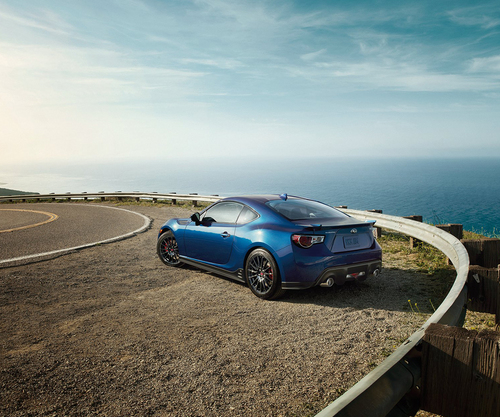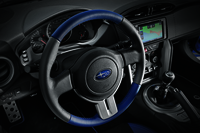2015 Subaru BRZ Series Blue Review by Carey Russ +VIDEO
 2015 Subaru BRZ Series Blue |
One of the best-balanced sports cars ever, and gets a sporty-looking update with the Series Blue limited edition
DRIVING DOWN THE ROAD WITH CAREY RUSS
• SEE ALSO: Subaru Buyers Guide
 2015 Subaru BRZ Series Blue |
Given the product lineups of Subaru and Toyota prior to the 2012 (model year 2013) debut of the joint-venture project that became the Subaru BRZ, Scion FR-S, and in other countries, the Toyota GT 86, the choice of a small, affordable 2+2 sports coupe may have seemed strange, especially a rear-wheel drive 2+2 sports coupe. Subaru had built its reputation on all-wheel drive, then standard throughout its model range. While the WRX gave it considerable high-performance credibility, Subaru hadn't made anything remotely resembling a sports coupe since the front- or all-wheel drive SVX of the 1990s. With the demise of the Celica and MR-2/MR-S and the Supra a distant memory, Toyota seemed out of the sports coupe segment for good.
So perhaps it was time for both manufacturers do do something different. Toyota had acquired a stake in Subaru, and how better to take advantage of that than a project that could leverage the engineering and design strengths of both manufacturers. Chassis and engine -- horizontally-opposed "boxer" of course -- were largely from Subaru, with Toyota's combination of direct and indirect fuel injection. Styling was primarily from the Toyota side, with more than a passing nod to its rare and exotic 2000GT of the late 1960s. Which itself was a product of a joint venture, with motorcycle maker Yamaha, and meant to show that Toyota could make more than merely appliance-like daily transportation vehicles.
Watch the original introduction of the Subaru BRZ concept
You're unlikely to ever see a 2000GT outside of a museum, as only around 350 were ever built. You've likely seen plenty of the Subieota/Toyobaru twins over the past two years, as its combination of affordable performance and the versatility of its 2+2 design have made it a success. The first rush of sales is over, it's no longer The New Thing, so what can be done to command attention?
On the Subaru side, it's special edition time. That would be the 2015 BRZ Series Blue, limited in number to 1,000. It's primarily cosmetic, a top-level Limited with an aero kit that does lower drag and increase downforce a bit. STI-badged alloy wheels and red-painted brake calipers complete the look on the outside, while inside you get leather and Alcantara on the seats, with blue-stitched trim and a faux-carbon fiber pattern on the dash. You were expecting real carbon fiber? Affordability is the word here, and real carbon fiber is still expensive. Turbo? Not yet, from the factory anyway -- and the BRZ is wonderfully well-balanced as is, no more power needed if you understand that it's all about finesse, not brute force. Plus, again, a turbo means more cost, and more cost in fuel and (likely) insurance. Ditto for all-wheel drive. And while the regular Limited trim level is offered with a choice of six-speed manual or automatic transmissions, the Series Blue is stick-only. Colors are trademark Subaru deep metallic blue ("WR Blue Pearl") and pearl white. Keep it simple…
The BRZ is a fine example of a real sports car that can also be an only car, not merely a weekend toy, and the 2+2 interior helps there. It's one of the best-handling cars made today, or ever, superbly balanced and great fun at a track day or autocross. And still comfortable as a daily driver. Add reasonable fuel economy, EPA 22/30 and 24 for my week with as little highway driving as possible, and what's not to like?
Fun look at the 2013 Subaru BRZ
APPEARANCE: How to differentiate the Subaru BRZ from a Scion FR-S? Metal body panels are shared, as are lights. At the front, bumper fascias are different. The grille shape is similar, but the BRZ's is widest at the top, with an inset bumper bar, while the FR-S's is widest at the bottom. The BRZ has wider, shorter faux brake ducts around its foglamps. It has a simulated air duct on each front fender; the FR-S has its opposed-piston/86 badges. At the rear, the only difference is badging. Either way, it looks like a proper 2+2 sports coupe, and only the use of modern bumper technology (a good thing) shows it to be contemporary rather than an exotic from the 1960s. The proportions are timeless. The Series Blue body kit consists of STI-badged front splitter, side sill extensions, and a more-aggressive diffuser-look panel under the rear, plus a bit more underbody paneling that stock.
 2015 Subaru BRZ Series Blue |
COMFORT: There is more differentiation between the twins inside than out, and I suspect Subaru had more of a hand in interior design. The BRZ is targeted at a slightly older buyer than the FR-S, so it's a bit more conservative, with less of a race-car look. The instrument panel looks very Subaru. Frameless door glass is definitively Subaru. There is no glare from the textured, soft-touch instrument panel top. The tachometer gets prime real estate, with the analog speedometer tucked away to the lower left. That's not a problem, as a digital speed display is set into the tach. The steering wheel is all business, with no control buttons. It's manually-adjustable for tilt and reach, and the driver's seat has cushion height adjustment, so all drivers can find their perfect driving position. Seats here have grippy Alcantara cushions and backs, with leather used for the bolsters. Adjustment is manual and the front seats have heated cushions. Building on the Limited trim level, the Series Blue therefore has full audio choices, Bluetooth connectivity, dual-zone automatic climate control, and pushbutton start/stop -- with the STI logo on the button. In sports car terminology, "+2" means there are rear seats, but don't expect the room and amenities of a sedan. Five foot six is about the maximum back there, and only if front passengers are about the same size. The rear seatback folds in one piece for extra luggage capacity. The BRZ is not a hatchback, so structurally good and rigid, but access through the trunk lid can be tight. A space-saver spare tire and jack live under the cargo compartment floor.
SAFETY: Excellent four-wheel vented disc brakes with electronic brake force distribution and brake assist, traction control and vehicle stability control and precise steering and cornering ability are safety features as much as performance features. The BRZ's unibody structure is designed for passenger protection, and frontal, front side, and side curtain airbags are standard equipment.
RIDE AND HANDLING: The first drive I had in a BRZ was on a race track, at an automotive journalists' association track day. The BRZ was not the quickest or fastest car. It may not even have had the highest cornering limits. For me, it was by far the most fun to drive. On the track, limits are high, it's stable at speed and immediately responds to driver inputs from both the steering wheel and right foot. The rear end can be kicked out in a controlled manner -- not a good idea on the street -- but in case of a quick need for an emergency maneuver, an obstacle is more likely to be avoided by driving around it. Anyone who believes that electrically-assisted power steering has to be numb and without feedback needs to drive this car. There is just the right amount of road feel through the steering wheel. Good track cars often make poor road cars as the suspension setup that limits weight transfer from body yaw, pitch, and roll can be uncomfortably stiff once the adrenaline and endorphins wear off. No problem here. Yes, the BRZ's MacPherson strut/double wishbone suspension is (appropriately) firm, but not uncomfortably so. Interior noise levels are surprisingly low. A long day in the driver's seat is a pleasure.
PERFORMANCE: My how spoiled we've become. The major complaint I've heard about the BRZ is it's alleged lack of power. It has "only" 200 horsepower… from a 2.0-liter naturally-aspirated four-cylinder engine. One hundred horsepower per liter specific output and not a turbocharger in sight and this is anemic?? 0-60 in around 6.5 seconds and it's slow? If you really think that, I'd like to sentence you to some time in the 1970s or early 1980s… The engine, being from Subaru, is a horizontally-opposed in design, with four cylinders. It's low and short, and mounted well back in the chassis for optimum weight distribution. Its low height means a low center of gravity, for less weight transfer when cornering and consequent improvement in adhesion and handling characteristics. Dual overhead camshafts, with variable cam phasing on all, and a combination of direct and port fuel injection, plus a high 12.5:1 compression allow it to make efficient power. That 200 hp is developed at a high 7000 rpm. Torque peaks at 151 lb-ft at 6400 rpm. Yes, it likes to rev. There is enough torque down low for easy drivability and good fuel economy in everyday driving, but it really comes alive over 4500 rpm. The Series Blue is stick only, and that's the best transmission for this car anyway. Shifting is quick and smooth, and a pleasure. A standard Torsen limited-slip differential ensures that power gets to the ground efficiently. EPA fuel economy is listed as 22 mpg city, 30 highway. With minimal highway use and maximum backroad fun I got 24 mpg for my week.
CONCLUSIONS: The Subaru BRZ continues as one of the best-balanced sports cars ever, and gets a sporty-looking update with the Series Blue limited edition for 2015.
SPECIFICATIONS
2015 Subaru BRZ Series Blue
Base Price $ 27,695
Price As Tested $ 30,285
Engine Type DOHC 16-valve horizontally-opposed 4-cylinder with variable cam phasing on all camshafts and both direct and port fuel injection
Engine Size 2.0 liters / 122 cu. in.
Horsepower 200 @ 7000 rpm
Torque (lb-ft) 151 @ 6400 rpm
Transmission 6-speed manual
Wheelbase / Length 101.2 in. / 166.7 in.
Curb Weight 2776 lbs.
Pounds Per Horsepower 13.9
Fuel Capacity 13.2 gal.
Fuel Requirement 91 octane unleaded premium gasoline
Tires 215/45 R17 87W Michelin Primacy HP
Brakes, front/rear vented disc all around, dual-piston front and single-piston rear calipers. ABS, EBD, BA standard
Suspension, front/rear independent MacPherson strut / independent double wishbone
Drivetrain front engine, rear-wheel drive
PERFORMANCE
EPA Fuel Economy - miles per gallon city / highway / observed 22 / 30 / 24
0 to 60 mph 6.5 sec
OPTIONS AND CHARGES
Series Blue Edition -- includes: STI aero kit, 17" STI black-finish alloy wheels, leather and Alcantara-trimmed interior with blue highlights and stitching, red-painted brake calipers, carbon fiber-pattern trim $2545 - $750 discount $ 1,795
Destination Charge $ 795


